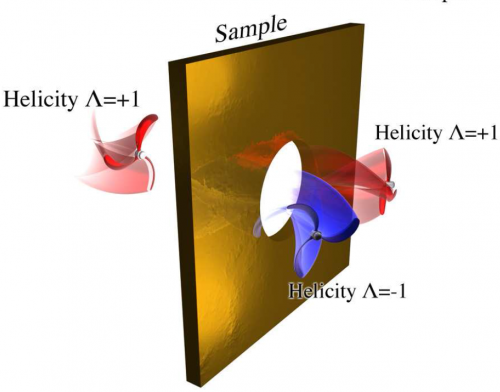Twisting the light away using ultrasmall holes

A new study shows that light transmitted through apertures smaller than the wavelength of light go through a radical change, splitting into two symmetrical counter-rotating polarisations.
Researchers from Macquarie University, in collaboration with the Australian National University in Canberra, shone a focused red laser through a thin gold mirror perforated with round holes ranging in size from 50 to 600 nanometres. Although most of the light was reflected, a small fraction of the light passed through the hole with altered polarisation properties.
"A circularly polarized light beam has rotating electric and magnetic fields. In our experiments, we observed that after the nanohole, part of the light had a polarisation rotating in the opposite direction," said lead researcher Associate Professor Gabriel Molina-Terriza, from the Centre of Excellence for Engineered Quantum Systems (EQuS), which funded the research.
"It was a puzzling observation. All the elements that the light was traversing, including the aperture, were perfectly round, so we couldn't figure out what was causing the change of the polarisation of the light. We realised the cause for this counterintuitive phenomenon was that a hidden symmetry of the electromagnetic fields was broken in our experiment: the electromagnetic duality."
The researchers observed that the flips in the rotation were relatively stronger for small holes compared to the larger ones. The changes in helicity reveal how the nanoholes were reacting differently to the electric and magnetic fields.
The helicity of any quantum particle, including the quantum particles composing light (photons), is defined as the projection of the angular momentum on the direction of the linear momentum. In the case of electromagnetic fields, this relates to the circular polarisations of the electromagnetic field. Therefore, a light field changing circular polarisation in the interaction with a particle shows that the duality symmetry is broken.
The polarisation of light is now used in numerous applications including 3D displays and sunglasses, but also to characterise materials. Breakthroughs in nanophotonics such as this allow greater manipulation of photons at the nanoscale, and will assist in the development of new biosensors and the improvement of solar cell efficiencies.
Further studies will facilitate the use of light fields to quantum control the electronic properties of very small metallic particles, and to design ultrasensitive sensors.
The full research paper "Experimental control of optical helicity in nanophotonics" has been published in the journal Light: Science & Applications (LSA), from the Nature Publishing Group (NPG).
More information: The full research paper, "Experimental control of optical helicity in nanophotonics," is available online: www.nature.com/lsa/journal/v3/ … 6/pdf/lsa201464a.pdf
Journal information: Light: Science & Applications
Provided by Macquarie University





















